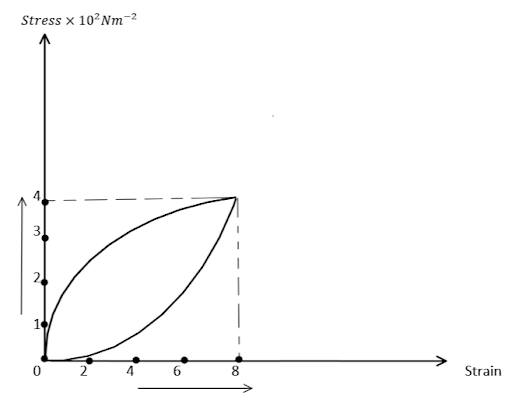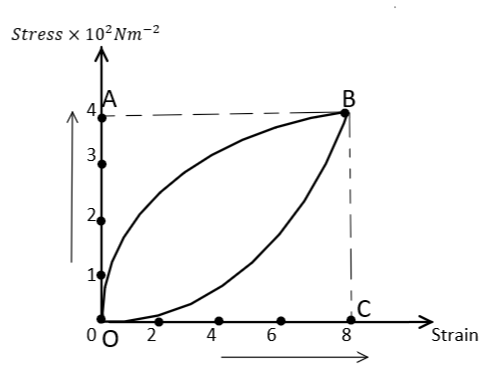
A rubber of volume $2000cc$ is alternately subjected to tension and released. The figure shows the stress-strain curve of rubber. Each curve is a quadrant of an ellipse. The amount of energy lost as heat per cycle per unit volume will be

A. $\left( {\dfrac{\pi }{2} - 1} \right) \times 16 \times {10^2}J$
B. $\left( {\dfrac{\pi }{4} - 1} \right) \times 8 \times {10^2}J$
C. $\left( {\dfrac{\pi }{4} - 1} \right) \times 32 \times {10^2}J$
D. $\left( {\dfrac{\pi }{2} - 1} \right) \times 32 \times {10^2}J$
Answer
219k+ views
Hint:This problem is based on the mechanical properties of solids especially on stress-strain curve hence, in this question, to find the heat lost per cycle, add the area of a quadrant of two ellipses formed in a figure and then subtract the area of the rectangle in which two quadrants are enclosed in order to get an accurate solution.
Complete step by step solution:
Volume of Rubber $V = 2000cc = 2000 \times {10^{ - 6}}{m^3} = 2 \times {10^{ - 3}}{m^3}$ (given)
Now, Work Done per cycle will be: -
Work Done per cycle = Area Bounded between two curves
By Geometry as shown in figure 2,
Work Done per cycle = Area of quadrant OBA + Area of quadrant OBC - Area of rectangle OABC
Also, we know that the area of quadrant in an ellipse is ${\left( {a{r_{quadrant}}} \right)_{ellipse}} = \dfrac{{\pi ab}}{4}$

Therefore, $WorkDone = ar(OBA) + ar(OBC) - ar(OABC)$
$ \Rightarrow \dfrac{{\pi \times 4 \times {{10}^2} \times 8}}{4} + \dfrac{{\pi \times 8 \times 4 \times {{10}^2}}}{4} - 8 \times 4 \times {10^2}$
Taking $\left( {8 \times 4 \times {{10}^2}} \right)$ common, we get
$ \Rightarrow \left( {8 \times 4 \times {{10}^2}} \right)\left( {\dfrac{\pi }{4} + \dfrac{\pi }{4} - 1} \right)$
$ \therefore \left( {\dfrac{\pi }{2} - 1} \right) \times 32 \times {10^2}$
But as we know that Work Done per cycle is also equal to energy lost per cycle per unit volume. Thus, the amount of energy lost as heat per cycle per unit volume is $\left( {\dfrac{\pi }{2} - 1} \right) \times 32 \times {10^2}J$.
Hence, the correct option is D.
Note: Since this is a problem related to stress-strain curve analysis hence, given conditions are analyzed carefully by using the figures in calculation precisely. Quantities required to calculate heat lost per cycle per volume must be identified on a prior basis as it gives a better understanding of the problem.
Complete step by step solution:
Volume of Rubber $V = 2000cc = 2000 \times {10^{ - 6}}{m^3} = 2 \times {10^{ - 3}}{m^3}$ (given)
Now, Work Done per cycle will be: -
Work Done per cycle = Area Bounded between two curves
By Geometry as shown in figure 2,
Work Done per cycle = Area of quadrant OBA + Area of quadrant OBC - Area of rectangle OABC
Also, we know that the area of quadrant in an ellipse is ${\left( {a{r_{quadrant}}} \right)_{ellipse}} = \dfrac{{\pi ab}}{4}$

Therefore, $WorkDone = ar(OBA) + ar(OBC) - ar(OABC)$
$ \Rightarrow \dfrac{{\pi \times 4 \times {{10}^2} \times 8}}{4} + \dfrac{{\pi \times 8 \times 4 \times {{10}^2}}}{4} - 8 \times 4 \times {10^2}$
Taking $\left( {8 \times 4 \times {{10}^2}} \right)$ common, we get
$ \Rightarrow \left( {8 \times 4 \times {{10}^2}} \right)\left( {\dfrac{\pi }{4} + \dfrac{\pi }{4} - 1} \right)$
$ \therefore \left( {\dfrac{\pi }{2} - 1} \right) \times 32 \times {10^2}$
But as we know that Work Done per cycle is also equal to energy lost per cycle per unit volume. Thus, the amount of energy lost as heat per cycle per unit volume is $\left( {\dfrac{\pi }{2} - 1} \right) \times 32 \times {10^2}J$.
Hence, the correct option is D.
Note: Since this is a problem related to stress-strain curve analysis hence, given conditions are analyzed carefully by using the figures in calculation precisely. Quantities required to calculate heat lost per cycle per volume must be identified on a prior basis as it gives a better understanding of the problem.
Recently Updated Pages
Two discs which are rotating about their respective class 11 physics JEE_Main

A ladder rests against a frictionless vertical wall class 11 physics JEE_Main

Two simple pendulums of lengths 1 m and 16 m respectively class 11 physics JEE_Main

The slopes of isothermal and adiabatic curves are related class 11 physics JEE_Main

A trolly falling freely on an inclined plane as shown class 11 physics JEE_Main

The masses M1 and M2M2 M1 are released from rest Using class 11 physics JEE_Main

Trending doubts
JEE Main 2026: Application Form Open, Exam Dates, Syllabus, Eligibility & Question Papers

Derivation of Equation of Trajectory Explained for Students

Hybridisation in Chemistry – Concept, Types & Applications

Understanding the Angle of Deviation in a Prism

Understanding Collisions: Types and Examples for Students

Understanding Atomic Structure for Beginners

Other Pages
JEE Advanced Marks vs Ranks 2025: Understanding Category-wise Qualifying Marks and Previous Year Cut-offs

Units And Measurements Class 11 Physics Chapter 1 CBSE Notes - 2025-26

NCERT Solutions For Class 11 Physics Chapter 8 Mechanical Properties Of Solids

Motion in a Straight Line Class 11 Physics Chapter 2 CBSE Notes - 2025-26

NCERT Solutions for Class 11 Physics Chapter 7 Gravitation 2025-26

How to Convert a Galvanometer into an Ammeter or Voltmeter




